Route 20 Chess Club
Freeport, Illinois, May 25, 2010
1.d4 d5 2.c4 e6 3.Nc3 a6?
A weak response, possibly intended to prepare ...b5 or prevent the utterly improbable Nb5. 3...c6 is the most solid response to the line, 3...Nf3 the most popular. 3...Be7 isn't unreasonable either.
4.e4
I'm looking to take advantage of Jim's failure to play 3...Nf3 or 3...c6, but more direct is 4.cxd5 exd5 5.Nf3 Nf6 6.Qb3.
4...dxe4 5.Nxe4 Nf6
There was also 5...Bb4+ to consider.
6.Bg5
I'm reluctant to trade, but 6.Nxf6 Qxf6 7.Nf3 is the only move.
6...Be7
Better is 6...Bb4+ 7.Nc3 c5.
7.Qd3??
We're both stumbling through this offbeat QGD offshoot. With this queen move, I'm trying to defend my knight and my d-pawn simultaneously, but it doesn't really work: with 7...Nxe4! 8.Bxe7 Qxe7 9.Qxe4 Qb4+! 10.Kd1 Qxb2, my king is exposed, I can't castle anymore, I'm down a pawn, and I'm about to lose another. In light of this potential calamity, I'm still better off trading on f6: 7.Nxf6+ Bxf6 8.Bxf6 Qxf6.
7...Bb4+
Fortunately for me, Jim overlooks the threat too.
For the next dozen moves or so, it's more as though Jim is playing white and I'm playing black: he's trying to generate some kind of attack, and I'm batting his efforts aside, to his mounting frustration.
8.Nc3 Nbd7 9.Nf3 h6 10.Bh4 0-0 11.Be2 c5 12.0-0 cxd4 13.Nxd4
I miss a good opportunity here in 13.Qxd4 e5 14.Nxe5 Nxe5 15.Qxe5 Re8 16.Rad1, winning a pawn.
13...Nc5 14.Qe3 Bxc3 15.Qxc3
I could recapture with 15.bxc3 here. The doubled pawns aren't much of a problem -- they just give me the lovely b-file for one rook and d-file for the other.
15...e5
The game is going to be all about this pawn for a while.
16.Nf3 Re8 17.Rad1 Qe7 18.Bxf6 Qxf6 19.Rd5 Ne4
An aggressive "forward retreat," but 19...Nd7 is better: it both saves the knight and adds another defender to the e-pawn.
20.Qa5
There was nothing wrong with 20.Qe3 Bf5 21.Rfd1. With this move, I effectively give up my assault on the e-pawn. But I'm OK with that -- with his knight move, Jim has blockaded his own pawn's advance, so I needn't fear ...e4 threatening exf3 anymore. Still, my backing down gives Jim more freedom of movement.
20...b6 21.Qa3 Bg4 22.Rfd1 b5
Jim's threat is not ...b4 but ...bxc4. I can't resist.
23.c5
Perhaps I should have resisted, though, since 23.cxb5 is actually better: if 23...axb5 24.Qe3, then 24...Rxa2 loses a piece to 25.Qxe4. And better still is to move the queen right away: 23.Qe3 Bxf3 24.Nxf3, also threatening Qxe4.
23...Red8??
Jim really needs to get that knight out of the way of his e-pawn. This move gives me a chance to triple my heavies on the e-file with a threat on the knight as well: 24.Qd3! Rxd5 25.Qxd5 Rc8 26.Qxe4. After that, the bloodbath continues 26...Bxf3 27.Qxf3 Qxf3 28.Bxf3 Rxc5, heading into an endgame with white up a bishop for a pawn. Yow! That would have made an exciting finale to this game . . . if, y'know, any of it had actually happened.
24.h3 Bxf3 25.Bxf3 Ng5 26.Bg4 Ne4
Fritz says forget that -- instead, trade rooks on d5 and push the pawn!
27.Qf3 Qxf3??
A straightforward queen trade, right? Wrong. What tactic are Jim and I both missing? (Highlight to reveal answer.)
28.Rxd8+!! Rxd8 29.Rxd8+ Kh7 30.Bxf3 and white goes into the endgame a rook ahead.
28.Bxf3 Rxd5 29.Rxd5 Nf6
Jim has to retreat the hanging knight, but 29...Ng5 gives him 30.Rxe5?! Nxf3+ 31.gxf3 Kf8, giving his pawn a respite (white needs to play 30.Bg4 to defuse the threat) and allowing it to advance.
30.Rxe5 Rd8 31.c6
A little imagination reveals that playing 31.Bb7 first both attacks black's a-pawn and guards the c-pawns promotion square.
31...Ne8? 32.Rc5
Lucky Jim. If I play 32.Re7, his a-pawn is history (32...Kf8 33.Ra7). He could have prevented it with 31...Kf8.
32...Nc7 33.b4 Rd2 34.a3 Ra2 35.Rc3 Ra1+ 36.Kh2 Ra2??
This move looks natural, but it's horrible! Watch what happens if white has his head screwed on straight: 37.Rd3!? Rxf2 38.Rd8+ Kh7 39.Rd7 Ne8 40.Rxf7. White regains his dropped pawn, and the knight is going to die falling on that little grenade on the c-file.
Note to self: When you're a pawn up, don't let the loss of a pawn stop you from looking for an attack.
37.Kg3
Bah. Sensible and tame. Not in the spirit of the position.
37...g6 38.Rd3
A move too late. After, say, 38...Kg7 39.Rd7? Ne6 is merely pitiful (40.c7?? Rc2).
38...h5??
The bad thing about this move is that it sorta kinda allows 39.Rd7 to work (39...Ne6 40.Bd5 Rxa3+ 41.f3 Rc3 42.Bxe6 Rxc6 43.Bxf7+ Kf8 drops the knight).
39.Bd1
I . . . I don't know what I'm thinking with this move. Bb3, maybe? 39.Rd7 is the only move worth considering.
39...Rb2??
I guess Jim is reading my mind and dodging the stupid move that I shouldn't make anyway.
40.Rd7 (finally) Ne6 41.c7 Nxc7 42.Rxc7 Rd2
Let's see, now . . . when you're a piece up in a straightforward, almost symmetrical endgame, what do you do?
43.Bb3?????????
Seriously, I have to give it that many question marks because of the utter delight with which it fills Jim. You see why, right? I'm not even going to insult your intelligence by making you highlight it.
43...Rd3+ 44.Kf4 Rxb3
Sigh.
"I've been waiting this whole game for you to make that one mistake you always make," crows Jim. Yeah, yeah. I'm not done fighting.
45.Ke5 Rb2 46.Ra7 Rxf2 47.Rxa6 Rxg2 48.a4 bxa4 49.b5??
49.Rxa4 is a no-brainer -- kills the a-pawn, defends the b-pawn. This dumb move just sets up a skewer.
49...Rg5+ 50.Kf6 Rxb5 51.Ra8+ Kh7 52.Kxf7 Rb7+
52...Rb3 followed by 52...Rxh3, roll credits.
53.Kf6 Kh6
Goodness gracious . . . after all that, we're heading into draw territory.
54.Rh8+ Rh7 55.Ra8 Rc7
56.Rxa4??
If I just keep swooping in with Rh8+ and back out, I can force a threefold easily. Two pawns down, why am I still trying to win? It's not going to happen.
56...Rc3 57.Ra8??
Now Jim can check me, and I can forget about that forced draw.
57...Rf3+ 58.Ke5 Rxh3 59.Rh8+ Kg5 60.Rf8 Kh4 61.Rf4+ Kg3 62.Ke4 g5
Jim can force a win here with 62...Rh4! 63.Rxh4 Kxh4 64.Kf3 -- the g-pawn will promote.
63.Rf3+ Kg2 64.Rf5 g4 65.Rg5 g3 66.Kf4
I'm gambling that I can get Jim so cramped in the corner that he'll be forced to drop something.
66...h4 67.Kg4 Kh2 68.Kf3 Kh1
68...g2! 69.Ke4 Rg3 is Jim's only chance to force a win.
69.Kg4 g2??
Swindle achieved! (Jim needs to play 69...Rh2 first to save himself.)
70.Kxh3 g1Q 71.Rxg1+ Kxg1 72.Kxh4 ½-½

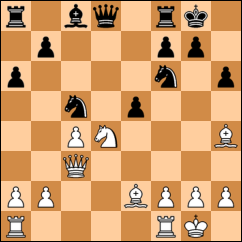
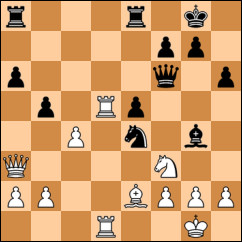
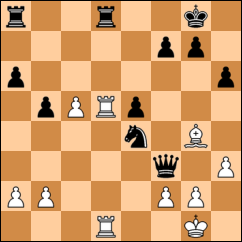
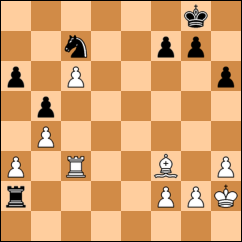
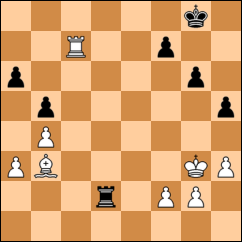
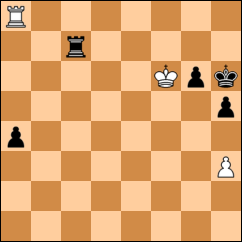



0 comments:
Post a Comment